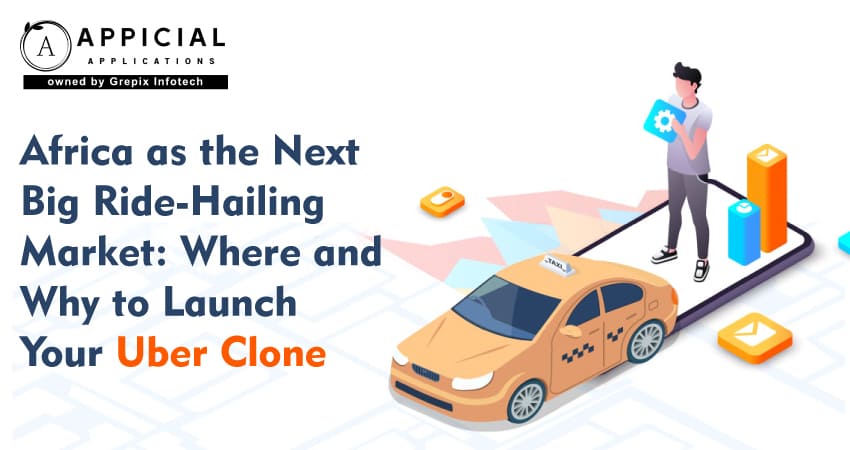
Africa as the Next Big Ride-Hailing Market: Where and Why to Launch Your Uber Clone
Africa is shifting gears are you ready to ride the wave? With rapid urbanization, a tech-savvy youth population, and skyrocketing smartphone usage, Africa is emerging as the next global hotspot for ride-hailing innovation.
Valued at billions and still accelerating, the continent’s mobility revolution is opening doors for entrepreneurs, investors, and developers alike. offers unmatched potential.
In this blog, we explore the continent’s rising demand for safe, smart, and affordable transportation, uncover the top countries to launch your ride-hailing startup, and outline the biggest challenges, plus how to solve them with locally tailored tech.
If you're considering launching your own taxi app in Africa, this guide is your roadmap.
Africa is fast becoming a prime market for ride-hailing apps, expected to reach $3.16 billion by 2030. With rising urbanization, smartphone usage, and a growing middle class, countries like Nigeria, South Africa, Kenya, and Ghana are driving demand for safe, affordable, and tech-enabled transportation. From motorcycle taxis in Uganda to cash-based payments in Central Africa, the continent offers immense potential for launching an Uber clone in Africa. This blog dives into market insights, country-specific opportunities, challenges, must-have app features, and a smart go-to-market strategy to help you tap into Africa’s mobility revolution.
Africa as the Next Big Ride-Hailing Market
Is Africa the next big goldmine for ride-hailing apps? Absolutely and the numbers prove it. The African ride-hailing market is expected to reach $3.16 billion by 2030, increasing by 4.5% annually (Mordor Intelligence).This expansion means a massive opportunity for anyone wishing to start an Uber Clone in Africa.Passengers, nowadays, desire inexpensive, convenient, and secure transportation, and apps provide it.
So, if you're planning to begin your own ride-hailing business, it's time to act now!
Africa’s Mobility Landscape: What is It?
The mobility landscape in Africa is making a radical shift, spurred by widespread urbanization, higher smartphone penetration, and a rising middle class.
Currently, approximately 30% of African urban dwellers use ride-hailing services monthly. South Africa, Kenya, Zambia, and Ghana are leading this movement. Major players such as Bolt, Uber, and Yango hold huge stakes in most markets. Bolt is well established in South Africa and Nigeria, and Yango is expanding rapidly in West Africa. However, local startups such as Gozem (Togo) and SafeBoda (Uganda) are taking local habits and budgets into account by providing corresponding services (Sagaci Research).
This expansion creates opportunities for developers to develop the next major taxi app that African customers can trust. From offline payments to cash bookings, there's a demand for features that resonate with local realities. That's why starting an Uber clone in Africa provides the same battle-tested tech, tailored to Africa's specific needs.
Additionally, electric cars, delivery options, and subscription services are also becoming a part of Africa's mobility narrative. As more and more individuals require quick and adaptive transportation, the market will become even more robust. To investors, developers, and startup entrepreneurs, Africa's roads point to huge possibilities.
Where to Launch Your Uber Clone in Africa: Best Ride-Hailing Markets!
The ride-hailing market in the continent is flourishing, and some countries are better than others in terms of opportunities.
South Africa
The country's total shared mobility market was around USD 3.3 million in 2023, with the majority of it belonging to ride-hailing. Aggressively, the market is projected to grow, with a Compound Annual Growth Rate (CAGR) of 10.1% from 2024-2040, as per Grand View Research.
Major city hubs such as Johannesburg, Cape Town, and Durban drive this expansion, thanks to high-density populations within the cities, increasing traffic jams, and increasing demand for efficient, safe, and affordable modes of transport.
The big players Uber and Bolt dominate the market, with homegrown startups also coming on board, focusing on local transport requirements as well as price structures.
Nigeria
Nigeria is the largest and most dynamic ride-hailing market in the continent. Nigeria's economic hub, Lagos, boasts a million motorcycle taxis called "okadas" in Nigeria, which is a testament to demand and disorder in the informal ride-hailing sector.
That opens the door for formal ride-hailing platforms to formalize transport, make transport safer, and facilitate digital payments.
Companies such as Bolt, Uber, and inDriver operate in Nigeria, while local solutions such as Max.ng and Gokada are utilizing motorcycle and tricycle services to fulfill last-mile mobility requirements.
Kenya
Kenya's ride-hailing industry is experiencing a speeding up of digital adoption and urbanization, particularly in Nairobi. Worldmetrics approximates that over 40% of customers utilize ride-sharing services for airport pick-up and drop-off, indicating a preference for convenience and reliability in punctuality-heavy transportation arrangements
Operators like Uber, Bolt, and Little Cab (a locally grown substitute sponsored by Safaricom) lead the Kenyan market. Relatively good internet penetration in the country, use of mobile money (notably M-Pesa), and traffic congestion make ride-hailing a convenient substitute for conventional taxis or matatus (public minibuses). As the market matures, increasingly localized Uber clone in Africa models will appear, customized to regional infrastructure and user behavior.
Ghana
Ghana is experiencing increasing ride-hailing use, fueled by an expanding middle class, urban growth, and higher smartphone penetration. TGM StatBox reports that around 42% of users in Ghana used a ride-hailing service recently, as digital transport solutions are increasing in popularity.
Accra, Kumasi, and Takoradi are some of the major cities in which businesses have established a dominant market presence. With the government enhancing infrastructure and levels of digital literacy increasing, the ride-hailing segment in Ghana will witness consistent growth. So, it’s another good opportunity for people who wish to launch their taxi app in Africa.
Central Africa
The Central African market is slowly accepting ride-hailing technologies. The industry, being early-stage, has the potential to reach USD 81.42 million by 2025 at a CAGR of 5.8%, as indicated by Statista. Although not as mature as East or West African markets, urban areas in Cameroon, Gabon, and the Republic of Congo are witnessing growing demand for contemporary transportation solutions.
Local firms and international platforms are now starting to venture here with services suited to local infrastructure and economic realities. As the mobility Africa landscape continues to evolve, mobile hailing, cashless payment, and motorcycle taxis will be the ones to lead market penetration in the early stages.
Uganda
Uganda is a ride-hailing leader on motorcycles as a result of SafeBoda, a locally founded startup with secure, dependable, technology-driven motorcycle taxis. It is the market leader in Uganda and has been able to venture into Kenya and Nigeria successfully.
In cities such as Kampala, where traffic and substandard public transport make work journeys frustrating, motorcycle taxis ("boda-bodas") are a quicker, more convenient solution. SafeBoda's digitally paid, helmeted, safety-trained model has set a new benchmark in East African urban mobility.
What are the Ride-Hailing Challenges in Africa?
Some of the issues you might encounter prior to the launch of your Uber clone in Africa include:
- Bad Roads The majority of African cities have bad roads with potholes and rough surfaces. It causes delays, more fuel utilization, and vehicle wear and tear. The drivers pay extra for repairs, and the passengers experience rough rides.
- Traffic Jams Lagos, Cairo, and Nairobi are among the most congested cities. Drivers and passengers experience wasted time due to long travel times. The traffic further adds to the fuel expense, hence making the rides more costly.
- Unstable Fuel Prices The prices of fuel in most African nations keep changing. This complicates it for drivers to have reasonable prices and constant earnings. Drivers also risk increased prices, reducing demand.
- Payment Issues Not everybody pays with cards or mobile payment systems, particularly in rural settings. Cash payments can delay the transaction, and it may not be convenient to carry cash for riders or drivers.
- Vehicle Shortage In other cities, there simply aren't enough cars or motorcycles to go around, particularly during rush hours. This creates long delays and annoyed customers.
Also Read: The Truth About Ride-Hailing And Ride-Sharing: How They Differ
What Should be the Localized App Features in Africa?
Localized applications in Africa, particularly taxi apps in Africa, have to serve regional requirements and issues.
Some of the key features are mobile money capabilities to make payments offline, important for individuals without access to traditional banking. Offline support is also important because internet access is not always present in most areas. Support for multiple languages is also important because Africa is multicultural with numerous languages and dialects.
When creating an Uber clone in Africa, one must also promote local transport routines, for example, minibuses or motorcycle taxis, which are prevalent in certain regions. Security features, like authentication of the drivers and location tracking in real time, will build users' trust.
Moreover, pricing models should be offered at affordable prices aligned with the local economy to draw in a larger base of consumers. By integrating these localized characteristics, an Uber clone in Africa can succeed and address the unique needs of the multicultural African market.
What Should Be the Go-To Strategy for an Uber Clone in Africa?
Here is a go-to-market plan for the launch of a taxi app in Africa with major pointers:
- Market Research & Analysis Do in-depth research to grasp ride-hailing in Africa, user behavior, and competition.Find out specific regional requirements and gaps, adapting your service to local transport patterns (e.g., motorcycle taxis).
- Adaptation of Services Tailor the taxi app in Africa with features such as mobile money integration (e.g., M-Pesa) and multilingual support to suit various user bases.
- Competitive Positioning Emphasize competitive advantages over other platforms, including lower costs, indigenous transport, and alternative payment schemes.
- Partnerships Partner with indigenous businesses, payment service providers, and car owners to reach more people and establish brand awareness.
- Targeted Marketing Campaigns Initiate targeted campaigns emphasizing ease of use, safety, and cost-effectiveness of your ride-hailing Africa services Use social media, influencers, and local events to generate hype for your Uber clone in Africa.
- Launch Phases Roll out operations in large cities (e.g., Lagos, Nairobi, Johannesburg) prior to rolling it out in smaller towns.
The Bottom Lines
In summary, Africa's ride-hailing industry is thriving, and there are unlimited opportunities for those willing to stake their claim on its potential. As cities get increasingly urbanized and mobile technology spreads, the demand for taxi apps in Africa will not dwindle.
If you're thinking of launching your own Uber clone in Africa, then the time has never been more opportune. By serving local demand, offering competitive and reliable service, and adjusting your app to suit the peculiarities of the market, you can establish a successful niche for yourself within this promising territory.
The future of ride-hailing in Africa is rosy - don't let someone else scoop it up while you're not looking!
Looking out to start your own venture like Uber ? Try out our HireMe Taxi Uber Clone, the easiest way to kick-start your taxi business.Author's Bio

Vinay Jain is the Founder at Grepix Infotech and brings over 12 years of entrepreneurial experience. His focus revolves around software & business development and customer satisfaction.
Back to blog list




